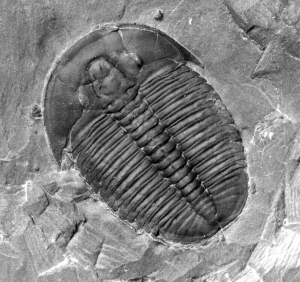

May 2016
|
Exceptional Fossil
Preservation - A Unique View on the Evolution of Marine Life |
I believe it is fairly evident that I do a lot of reading about paleontological topics. I recently decided to re-read a book I had reviewed in Jack’s Stacks back in January of 2003, Exceptional Fossil Preservation, Bottjer, et. al., eds., 2002. I want to quote a section from that book that is timely today in its relevance to restrictions to fossil collecting on certain Federal lands. The section is in Chapter 5, Burgess Shale- Type Locations, on pages 98-99.
 “Middle
Cambrian (Upper Delamaran-Marjuman) Spence Shale and Wheeler Shale and Marjum
Formations of Utah. Exposures of the Wheeler and Marjum Formations and the
Spence Shale in the Wellsville Mountains, Drum Mountains, and House Range are
well known for their trilobites (such as Elrathia kingii, which adorns
many a refrigerator magnet), having been quarried by commercial and avocational paleontologists for decades. Although Burgess Shale-type faunas are
rare within these units, extensive collecting efforts and generous donations of
specimens by avocational paleontologists have provided the most well documented
assemblage of Burgess Shale-type fauna outside the Chengjiang Lagerstätte.”
“Middle
Cambrian (Upper Delamaran-Marjuman) Spence Shale and Wheeler Shale and Marjum
Formations of Utah. Exposures of the Wheeler and Marjum Formations and the
Spence Shale in the Wellsville Mountains, Drum Mountains, and House Range are
well known for their trilobites (such as Elrathia kingii, which adorns
many a refrigerator magnet), having been quarried by commercial and avocational paleontologists for decades. Although Burgess Shale-type faunas are
rare within these units, extensive collecting efforts and generous donations of
specimens by avocational paleontologists have provided the most well documented
assemblage of Burgess Shale-type fauna outside the Chengjiang Lagerstätte.”
This particular chapter was written by James W. Hagadorn, Curator of Geology at the Denver Museum of Nature and Science. It is clear that Hagadorn is part of a long list of professional paleontologists that recognize the value of avocational collectors and was impressed enough to put it in writing. The Elrathia kingii trilobite mentioned in the quote above is probably the first trilobite many children ever get to see. It is so common that after the decades of collecting mentioned by Hagadorn, the supply is not exhausted; yet current regulations prohibit any kind of collecting in bulk. How does the anti-collecting clade of paleontologists foresee inspiring a future generation of dedicated professionals when they would restrict the collecting or even ownership of common fossils?